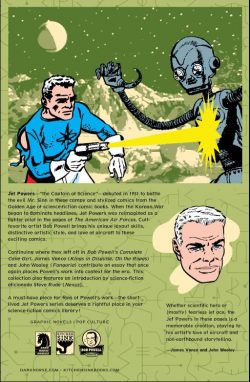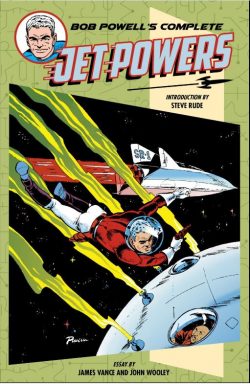

By Bob Powell with James Vance, John Wooley, Steve Rude & various (Kitchen Sink Books/Dark Horse)
ISBN: 978-1-61655-764-5 (HB) eISBN:978-1-63008-646-6
Like every art form, comics can be readily divided into masterpieces and populist pap, but that damning assessment necessarily comes with a bunch of exclusions and codicils.
Periodical publications, like pop songs, movies and the entirety of television’s output (barring schools programming and I’m not sure about them, anymore), are designed to sell stuff to masses of consumers.
As such, the product must reflect the target and society at a specific moment in time and perforce quickly adapt and change with every variation in taste or fashion. Although very much an artefact of its time, I consider the Buzzcocks single “Ever Fallen in Love (With Someone You Shouldn’t’ve)†to be the perfect pop song, but I’m not going to waste time trying to convince anybody of the fact.
For me, and perhaps only for me, it just is.
The situation is most especially true of comics – especially those created before the medium gained any kind of popular credibility: primarily deemed by their creators and publishers as a means of parting youngsters from cash. The fact that so many have been found to possess redeeming literary and artistic merit or social worth is simply post hoc rationalisation.
Creators striving for better, doing the very best they could because of their inner artistic drives, were being rewarded with just as meagre a financial reward as the shmoes just phoning it in for the paycheck…
That sad state of affairs in periodical publication wasn’t helped by the fact that most editors thought they knew what the readership wanted – safe, prurient gratification – and usually they were right.
Even so, from such swamps gems occasionally emerged…
A certain kind of two-fisted, brawny science fiction has always been part-&-parcel of the comics experience, and retrospectives – no matter how impressive – generally come with some worrisome cultural baggage. However, ways can be found to accommodate crystallised or outdated attitudes, especially when reading from a suitably detached historical perspective and even more so for many when the art is crafted by a master storyteller like Bob Powell.
After all, even though change is gradually coming now, it’s not that big a jump from fictionalised 1950s futures to the filmic metropolises of today where tech-bolstered (and usually white) Adonises with godlike power paternalistically save us all from something unimaginable, or our own folly, whilst winning over some initially unresponsive piece of feminine exotica…
I truly adore all comics in all genres from all eras, but sometimes the “guilty pleasure†alarm on my conscience just redlines every so often and I can’t stop it. Repeat after me, it’s not real. It’s not real, it’s never been real…
As businessmen, editors and publishers “knew†what hormonal kids wanted to see and they gave it to them. It’s no different today. Peruse any comic-shop shelf or cover listings site and see how many fully-clad, small-breasted females you can spot and how many hunky heroes pack teeny-weeny pistols…
No more prevaricating. Let’s talk about Bob…
Born in 1916 in Buffalo, New York, Stanley Robert Pawlowski studied at the Pratt Institute in Manhattan before joining one of the earliest comics-packaging outfits: the Eisner-Iger Shop.
He was a solid and dependable staple of American comicbooks’ Golden Age, illustrating many key features. He drew original Jungle Queen Sheena in Jumbo Comics plus other Jungle Girl features and Spirit of ’76 for Harvey’s Pocket Comics.
Powell handled assorted material for Timely titles such as Captain America in All-Winners Comics, Tough Kid Comics and sundry genre material like Gale Allen and the Women’s Space Battalion for anthologies like Planet Comics,Mystery Men Comics and Wonder Comics.
Relatively recently he was revealed to have co-scripted/created Blackhawk as well as drawing Loops and Banks in Military Comics and so many more now near-forgotten strips: all under a variety of English-sounding pseudonyms, since, white or not, the tone of those times was unforgiving for creative people of minority origins…
Eventually the artist settled on S. Bob Powell and had his name legally changed. Probably his most well-remembered and highly regarded tour of duty was on Mr. Mystic in Will Eisner’s legendary national newspaper insert The Spirit Section. After serving in World War II, Bob came home and quit to set up his own studio. Eisner never forgave him…
Powell – with assistants Howard Nostrand, Martin Epp and George Siefringer – quickly established a solid reputation for quality, versatility and reliability. They supplied a huge variety of material for Fawcett (Vic Torry & His Flying Saucer,Hot Rod Comics, Lash Larue); Harvey Comics (Man in Black, Adventures in 3-D and True 3-D) and Street & Smith’s Shadow Comics.
Powell was particularly prolific in numerous titles for Magazine Enterprises (ME), including TV tie-in Bobby Benson’s B-Bar-B Riders, Red Hawk in Straight Arrow; a short but bombastic turn with quasi-superhero Strong Man and timely sci fi frolic Jet Powers.
A master of the human form and caricature, Powell easily turned his hand to a vast range of genre staples – War, Western, Science Fiction, Crime, Comedy and Horror material – and consequently rendered, as a by-product, some of the best and most glamorous “Good Girl art†of the era, both in comics and in premiums/strip packages for business clients.
In the 1960s, he pencilled the infamous Mars Attacks cards, illustrated Bessie Little’s Teena-a-Go-Go and the Bat Masterson newspaper strip. He ended his days drawing Daredevil, the Human Torch and Giant-Man for Marvel.
This captivating hardback compilation and electrifying eBook edition gathers all the Jet Powers appearances – some possibly written by ubiquitous jobbing scripter Gardner Fox. ME publications employed a truly Byzantine method of numbering their comicbooks, but this title is little easier than most. All Jet issues were actually part of expansive umbrella anthology vehicle A-1 comics. Jet #1 was also A-1 #30 January 1951 – cover-splashed as Jet Powers and Space Ace – whilst #2-4 were A-1 #32, #35 and #39.
It makes no real difference to your enjoyment of what’s to come but satisfies my pedantic and didactic side…
This splendid tome includes a biography ‘Bob Powell (1916-1967)’, an effusive Introduction by Steve Rude and an erudite essay – ‘My First Encounter with the Two-Fisted Brainiac Jet Powers’– by John Wooley.
Jet Powers began as a classic holdover of a pristine pulp Sci Fi concept: the scientific everyman who solves all problems with razor-sharp intellect and a something he’s just handily cobbled together. Powers was actually a cut well-above the crowd of valiantly brilliant space-jockey boffins whizzing about the funnybook cosmos in the early 1950s: a cerebral genius, true, but one who nevertheless solidly stuck to the action-adventure side of the equation, and one who was ultimately mutated by world events and political frenzy into a man unrecognisable to his earlier antecedents.
We first meet “The Master of Atoms and Molecules†in Jet #1 1951 – cover-splashed as Jet Powers and Space Ace. ‘Captain of Science!’ introduces a solitary researcher roused to action after America is wracked by shattering earthquakes. It doesn’t take him long to confirm the events are being triggered by an evil enemy somewhere in Southern Asia…
Rocketing to the sinister citadel and armed with his trusty antigravity gun, Powers finds and foils the diabolical schemes of Mr Sinn while deeply upsetting the loyalties and affections of the madman’s sultry catspaw Su Shan…
The villain tries again in ‘The Man in the Moon!’, with meteors raining down on earth directed by his satellite fortress, but is again thwarted by the Man of Science after which a marauding intelligent alien bug ravages Earth, with only Jet capable of foiling ‘The Thing from the Meteor’…
In Jet #2 (April-June), Powers tackles an invasion from the future in ‘The Three-Million-Year-Old Men!’; Su Shan is abducted by mad scientist Marlon Stone and requires rescue from deadly beasts in ‘The House of Horror!’ after which background radiation from atomic tests grant intelligence, autonomy and megalomania to a pile of scrap who allies with Mr Sinn and propagates ‘The Metal Monsters!’ it needs to conquer Earth. Calling Jet Powers…
The tech terrors continue in Jet #3, beginning with a radioactive space cloud that cuts off sunlight. Thankfully Powers has a bold plan to destroy the ‘The Dust Doom!’ Shockingly for the era, he does not completely succeed and the series veers into post-apocalyptic dystopia…
As Earth recovers, deranged Professor Mikla unleashes biological atrocities via ‘The Devil’s Machine’, until Powers stops him. Barely pausing for breath Jet then jousts with Martians and Venusians to fend off ‘The Interplanetary War!’
Still feeling the effects of the doom-laden space dust, Earth endures ‘The Rain of Terror!’ in #4 as a cashiered general makes a bid for global domination and Jet spearheads a libertarian resistance, after which the industry trend for genre anthology sees Powers narrate the salutary tale of ‘The First Man in History Who Could Not Die!’.
Back in action for the last time as a science warrior, Jet then defeats ‘The Fleets of Fear!’ as war is rekindled by a Martian tyrant-in-waiting…
With no fanfare or warning the hero metamorphosed to follow a developing trend for anti-communist war stories, fuelled by the escalating Korean conflict. Jet morphed into The American Air Forces and, numbering maintained – #5/A-1 #45 in this instance – introduced visually identical ‘Army Air Ace Jet Powers’. Army Air Force Captain Johnny Powers is a fighter pilot from a family of fliers operating in Korea, but apparently afflicted with psychological inhibitions rendering him useless in combat. Not for long…
After a turbulent publishing year, issue #6/A-1 #54 opened 1952 in bombastic gung-ho style as Powers laments the noble, necessary sacrifice of a comrade on ‘MiG Alley Patrol’, after which #7(A-1 #58) introduces exotic fantasy as Powers and wingman Kenneth Loomis clash with murderous Red murderess Kali Soo in an ancient temple blasphemously converted into a commie fortress in ‘Whom the Gods Destroy!’
By the time of #8 (A-1 #65) comic book propaganda was in full swing as ‘Secret of the Tunnel’ lavishly adds torture, whipping and women in chains to the material Yankee kids could read. Despite being a jet ace, Powers spent a lot of time surviving crashes and battling on terra firma. After this fortuitous landing, he saves a slave girl and falls into a cavern full of North Korean ordnance he knows just how to ignite…
More of the same comes as 1952 closes as #9 (A-1 #69) finds him rescuing a downed buddy and narrowly dodging hundreds of ‘Bayonets Dipped in Blood!’, before 1953 opens with – and ends his service – in #12 (A-1 #91) with an actual aerial exploit as the fighter pilot downs a couple of MiGs, and narrowly avoids the typical Commie skulduggery of ‘The Death Trap’.
With the artistic action ended, this compelling compendium concludes with an incisive appreciation of the multi-talented hero courtesy of essay ‘The Jet Age’ by James Vance and John Wooley.
Despite my quibbles and cavils – and some genuine concerns about racial and gender holdover subtext of material produced 70 years ago – this book celebrates one of the mostly beautifully rendered characters in pictorial fiction and is a true tribute to the astounding talents of Bob Powell and his team. If you love perfect comic storytelling (of its time), but transcending fashion or trendiness, this is a treasure just waiting to be rediscovered.
Bob Powell’s Complete Jet Powers compilation © 2015 Kitchen, Lind and Associates LLC. Introduction © 2015 Steve Rude. “My First Encounter with the Two-Fisted Brainiac Jet Powers†© 2015 John Wooley. “The Jet Age†essay © 2015 James Vance and John Wooley. All rights reserved.
